IN THIS ISSUE
- Checkoff for wildlife
- Right whales: good to grim
- These hawks? No worries
- Beauty of spring ephemerals
- Bachman's sparrows back in black
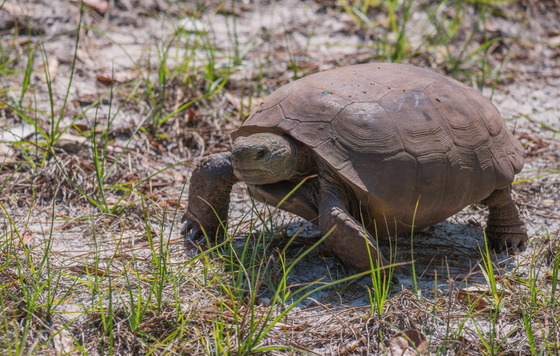 Georgia's wildlife checkoff benefits gopher tortoises and other native wildlife. (Jenny Burdette Photography)
We all know tax time is a pain.
But for Georgians, at least filing their state income taxes offers a unique opportunity to give native wildlife a leg – or wing, root, scale or fin – up. And unlike other things involving taxes, the Georgia Wildlife Conservation Fund checkoff is easy-peasy.
All you do is:
- Find the wildlife checkoff at line 10 on Form 500EZ or line 31 of Form 500.
- Fill in a donation: Any amount helps.
- Relax in knowing that your contribution will help conserve native wildlife not legally hunted or fished for – everything from bald eagles to gopher tortoises – plus rare plants and the wildlands these plants and animals need.
DNR’s Wildlife Conservation Section leads this work and depends on grants, donations and contributions. The Give Wildlife a Chance checkoff has been a key source of support since state lawmakers created it and what's officially called the Nongame Wildlife Conservation and Habitat Acquisition Fund 35 years ago.
The checkoff made up 7 percent of revenue in the last fiscal year. For more on what your giving goes to, see Conserving Georgia’s Wildlife: 2023.
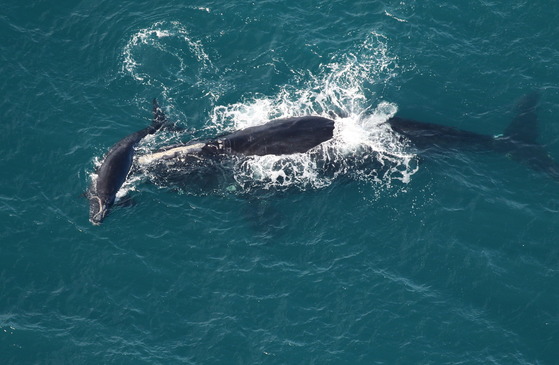 Braces (3320) and her calf off north Florida in December (CMARI/NOAA permit 26919)
The images that define this right whale calving season could not be more different.
There’s the promising, including the calf of Braces (right whale 3320) swim-playing around its mom.
There is the mix of hope and tragedy reflected in video of Juno (1612) and her calf, which survived being run over by a vessel within weeks of birth but whose severe wounds still threaten its growth and health.
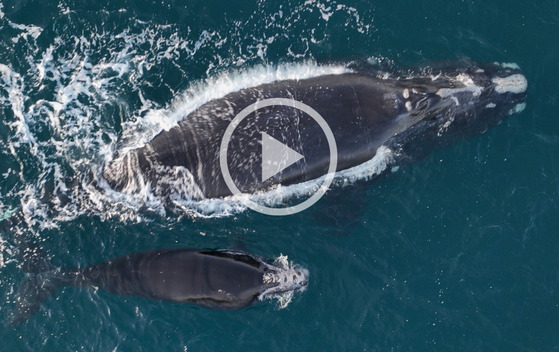 Juno (1612) and her injured calf about 20 miles off Sapelo Island Feb. 1 (DNR/NOAA MMHSRP permit 24359)
And there’s the grim, depicted in photographs of a year-old female found floating dead off Savannah and towed to Tybee Island. A necropsy done on the beach documented skull fractures and other signs of blunt force trauma that suggest this whale videoed swimming free only 10 days earlier was hit by a vessel before dying.
 The carcass of the juvenile right whale is analyzed on Tybee Island. (FWC/NOAA permit 24359)
The montage from the season underscores the plight of North Atlantic right whales, which rank among the most imperiled large whale species on Earth.
Each calf is critical. The total this winter on the whales’ only known calving ground – off the coast of Georgia, north Florida and the Carolinas – is up to 19. That’s the most documented since 2013.
But two of the 19 have disappeared and are presumed dead. The outlook for Juno’s calf is questionable. And research suggests that at least 50 calves a year are needed for right whales to recover; 25-30 to simply stabilize their current numbers.
Right whales won’t calve their way out of this, researchers say. Which points to human-caused problems. The two responsible for most deaths and injuries are entanglement in commercial fishing gear and vessel strikes.
The yearling born last winter only to end up food for sharks off Tybee this month is the latest example of the latter. For entanglements, look no further than the 3-year-old female that washed up on a Massachusetts beach in January with fishing rope embedded in her tail. NOAA said the rope "is consistent with rope used in Maine state water trap/pot buoy lines." The entanglement possibly dates to summer 2022, when the whale cataloged as no. 5120 was seen trailing 200 feet of line. Efforts to free her – at best a last-resort option for trying to save a whale – failed.
 DNR staff at the right whale necropsy on Tybee (Tyler Jones/DNR/NOAA MMHSRP permit 24359)
Both females were lost to a population that desperately needs them. Only about 360 North Atlantic right whales are left. Fewer than 70 are females capable of reproducing, according to NOAA.
As winter fades and the right whales that migrated to the Southeast start returning to foraging grounds off the northeastern U.S. and Canada, an Unusual Mortality Event continues to log deaths and injuries. The whale necropsied on Tybee was the 38th death since 2017. The number of seriously injured whales is up to 34.
This winter was senior wildlife biologist Jessica Thompson’s first leading right whale conservation work for DNR.
"It’s an extraordinary opportunity to see an incredible species on its calving grounds, visiting our coast,” Thompson said. “But as a scientist, it’s challenging to feel optimistic granted what we’ve seen this season – the gauntlet of anthropogenic threats they face just to survive."
Nineteen calves "is a good amount," she said. "But it’s not enough to change the tide on the possible extinction of these animals. Birth rate cannot be the only factor that changes.”
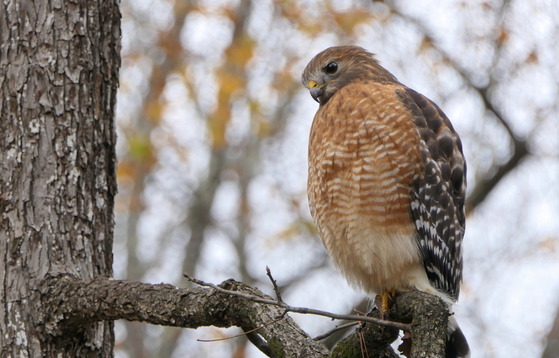 Red-shouldered hawk keeping watch (Linda May/DNR)
By TERRY W. JOHNSON
We have all heard a murder of crows loudly cawing near our homes.
Most know that in many cases the incessant, agitated calling can mean a predator is near.
But when we discover that the crows are targeting a red-shouldered hawk perched on a tree limb near our house, is it reasonable to fear for the safety of our pets or the birds visiting our feeders?
I'm glad you asked. …
Read Terry’s column to learn what these common hawks are usually hunting for.
Terry W. Johnson is a retired DNR manager and executive director of TERN, friends group of the Wildlife Conservation Section. Check out past columns and his blog. Permission is required to reprint a column.
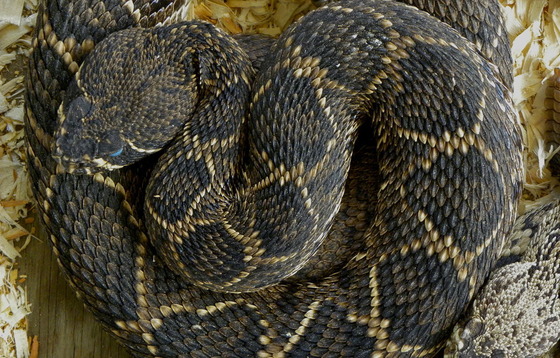 Milky-eyed eastern diamond-backed rattler about to shed its skin at the Claxton festival (DNR)
Buzztails headline the last two rattlesnake-focused festivals in Georgia next month. Both the Whigham Rattlesnake Roundup, set for March 2, and Claxton’s Rattlesnake & Wildlife Festival, March 9-10 in Evans County, are no-kill snake events that feature wildlife education programs along with kids’ activities and food, arts and crafts, and other booths. Just to the north, Fitzgerald will hold its Wild Chicken Festival March 15-16, having turned the former rattler roundup into a bash centered on the city’s Burmese wild chickens 24 years ago.
Bald eagles live-streamed at Berry College have done the unexpected. After the nesting couple’s first two eggs collapsed in January, a month later the female laid two more, bucking the trend of bald eagles seldom having second clutches.
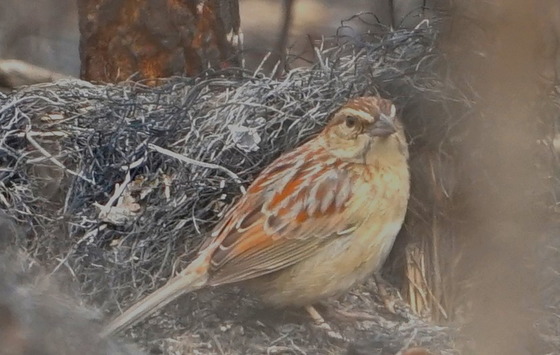 Bachman's sparrow in the "black" following a prescribed burn at Seminole State Park (Dennis Reist)
Bachman’s sparrows might be secretive but they apparently aren’t shy of foraging in newly burned woodlands. Seminole State Park campground host Dennis Reist photographed three of the rare sparrows looking for seeds and insects on 200-plus acres recently treated with prescribed fire by Interagency Burn Team partners at the south Georgia park. For insights on another sparrow species, read DNR's “Mice with Wings” blog post.
As celebrated in Prescribed Fire Week, fire-powered habitat restoration and maintenance is being done statewide by DNR and partners adhering to fuel and weather conditions called prescriptions. Most of these burns occur from mid-January through April, an effort that underscores prescribed fire as one of the most effective and efficient ways to enhance habitats and benefit fire-dependent species.
If you enjoy wildlife viewing in coastal Georgia, we want to hear from you. This brief online survey conducted by the University of Georgia Marine Extension and Georgia Sea Grant in concert with DNR will provide data to better understand this segment of eco-tourism, assess participation and estimate economic impacts.
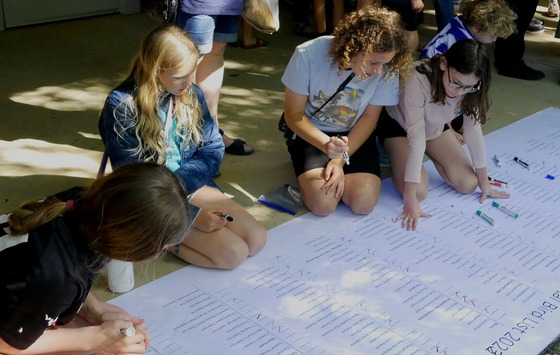 2023 birders mark species on a checklist at Charlie Elliott Wildlife Center (Ethan Hatchett/DNR)
Registration has opened for the 2024 Youth Birding Competition, a fun DNR birdathon in its 18th year of engaging kindergarteners through high-schoolers spotting birds statewide. The competition window is April 12-20, with a banquet the last night at Charlie Elliott Wildlife Center near Mansfield. Register by March 31. Need inspiration? Watch alumnus Angus Prichard in “Life after the YBC.”
Weekend for Wildlife raised over $3 million for wildlife conservation in Georgia this month. For 36 years, the fundraiser held each winter at The Cloister on Sea Island has provided critical support primarily for DNR work involving native nongame species, rare plants and natural habitats, but also for other initiatives, including this year a new Adaptive Hunting and Fishing Program.
Deer management in Georgia is guided by biological data, public input and management objectives described in DNR’s Deer Management Plan. But with a plan update due and public participation vital, review key issues and provide feedback before midnight April 7 in this virtual open house.
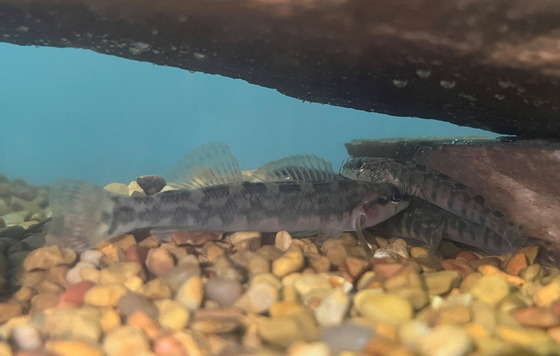 Blackbanded darters at the Warm Springs hatchery (Jessica Radich/USFWS)
Quick takes:
-
Blackbanded darters collected by DNR’s Stream Survey Team are being used as host fish at Warm Springs National Fish Hatchery to propagate endangered Ochlockonee moccasinshells, mussels found only in a small section of the Ochlockonee River and considered extirpated in Georgia.
- Recovering America’s Wildlife Act has added sponsors in the U.S. Senate and a possible challenger in the House, where the American Wildlife Habitat Conservation Act led by Bruce Westerman (R-Ark.) is raising questions about whether the differing legislation will lead to compromise or conflict.
- Joros could be coming to a city near you, suggests a University of Georgia study that analyzed the invasive Asian spiders living along busy roads and found they can tolerate the noise and vibrations common in urban areas.
-
Smithgall Woods State Park is about 200 acres larger following an addition to the Dukes Creek Conservation Area supported by federal and private foundation grants.
- “Longleaf Forever,” a 16-minute documentary about restoring longleaf pine habitats produced with DNR and The Environmental Resources Network support, won Best North American Short at the Wildlife Conservation Film Festival in Naples, Fla.
- With gopher frog breeding season in full swing, biologists are searching Georgia wetlands for egg masses from the state-listed frogs and collecting some for partners to rear for restoring and boosting wild populations.
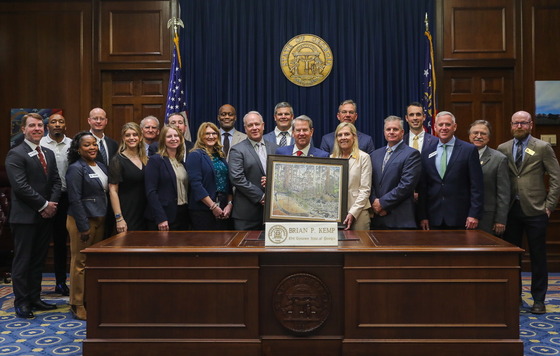 2024 DNR Forestry for Wildlife Partners with the governor and first lady (Office of the Gov.)
Names in the news: Gov. Brian and First Lady Marty Kemp joined DNR leaders in recognizing Forest Investment Associates, Georgia Power, Weyerhaeuser and PotlatchDeltic as 2024's Forestry for Wildlife Partners for their stewardship and management practices benefiting wildlife on nearly 1 million acres. Georgia’s Board of Natural Resources unanimously elected longtime member Joe Hatfield as chair last month, succeeding Dwight Davis. Retired DNR Deputy Commissioner Terry West of Conyers, who started his 35-year career as a game warden in Wilkinson County, died Feb. 1. Jason McRae landed this year's Georgia Bass Slam grand prize, which is fitting considering he is the sole angler to claim a Slam each of the program’s seven years and caught all 10 Georgia black bass species each time (five earns a Slam). U.S. Forest Service employees earning Forester’s Honor Awards in the Southern region included wildlife biologist Ruth Stokes and fire management officer Timothy Kolnik, both of the Chattahoochee-Oconee National Forest.
WHAT YOU MISSED ….
In the previous Georgia Wild:
- Amazing rattler survival story
- Rare birds back at Sprewell Bluff
- More right whale calves (and video)
- How native wildlife look at mistletoe
"Fungal plague killing Georgia’s bats; scientists are fighting back," The Atlanta Journal-Constitution
"Whale found dead off Tybee likely hit by vessel, officials say," Savannah Morning News and others, including CTV News (Canada) Atlantic
More right whale coverage:
- (+audio) "Right whale deaths 'devastating for the species,'" NPR
- "DNR provides area updates," WFOX and WJAX-TV (Jacksonville, Fla.)
- (+video) "Right whale found dead near Tybee Island," WSAV-TV (Savannah)
- "Another death renews calls for shipping regulations," ABC News
- (+video) "Calf still alive despite injuries from boat strike," FOX Weather
- "Injured calf raises speed concerns," Fernandina Beach (Fla.) News-Leader
- (+audio) "The long entanglement and short life of whale 5120," CAI (radio)
- (+video) "Rope on whale 'consistent with rope used in Maine,'" News Center Maine
- (+video) "S.C.-based aerial team studies whales," WBTW-TV (Myrtle Beach, S.C.)
- "Authorities slow speeders in calving grounds," Atlanta Journal-Constitution
(+audio, video) "Fire days shrinking in Ga.; what it means for wildfires, smoke pollution," (Columbus) Ledger-Enquirer and Georgia Public Broadcasting
"Smoke over state signals 'good fires' for wildlife habitat," WGXA-TV (Macon)
"DNR's Youth Birding Competition turns 18," Marietta Daily Journal
"Endangered woodpeckers return to Ga. WMA," WXIA-TV (Atlanta)
"Kemp, DNR announce 2024 Forestry for Wildlife Partners," EIN News and others, including Georgia Outdoor News
"Large invasive crab species spotted on Ga. coast," WAGA-TV (Atlanta)
"Agencies ask public to report invasive Cuban tree frogs," The Brunswick News
"Which species will invade Fla. next?" The Wildlife Society
"DNR Board OK funds for 13 outdoor projects," Capitol Beat
"Ga. advances titanium mine on edge of embattled Okefenokee," Bloomberg
"Ogeechee Tech wildlife club wins Riverkeeper award," AllonGeogia
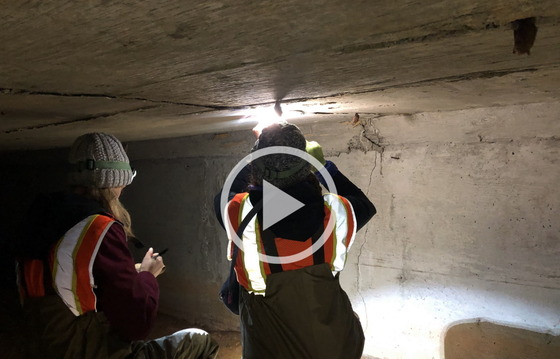 (audio) "DOT and DNR Partnership (for Bats)," DOT "Ahead of the Curve Podcast"
Sailboat added to artificial reef off Cumberland, DNR Coastal Resources Division
"A Beautiful Mess: Improving Brook Trout Habitat in Southeast," Trout Unlimited
"Meet the Ruffed Grouse," DNR Wildlife Resources Division
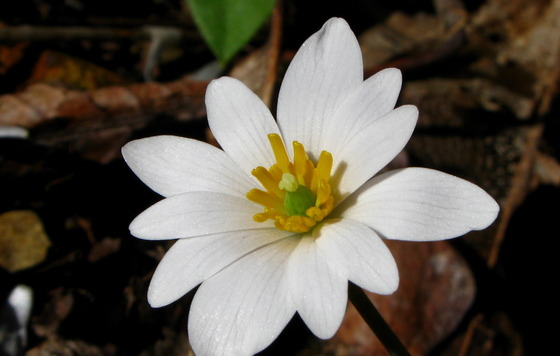 Bloodroot in bloom at Crockford-Pigeon Mountain WMA (Alan Cressler)
Spring in Georgia features some of the year's most beautiful flowers. While many people are familiar with non-native species such as daffodils and tulips, native spring ephemerals – from trout lilies to bloodroot – can be as spectacular, and they benefit wildlife. Spring ephemerals are plants that emerge and bloom from late winter to mid-summer. They grow from a dormant bulb, corm or other storage organ and are usually found in deciduous forests, emerging before the trees regain their leaves. Because the plants are active so early, they offer wildlife a reprieve from winter’s harshness, serving as a vital source of nectar and pollen for bumblebees, mining bees and many fly and gnat species. The small but showy plants are essential to healthy and diverse pollinator populations. Also, without spring ephemerals, more woodland plants would struggle to bloom and set seed. As you welcome spring's longer stretches of warmer weather, keep watch for emerging ephemerals.
- Ethan Hatchett
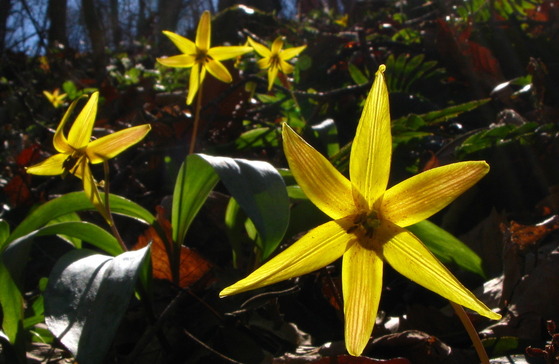 Trout lilies (Alan Cressler)
Speaking of spring ephemerals, Wolf Creek Trout Lily Preserve in south Georgia’s Grady County has been added to the Old-growth Forest Network. The county-owned 140-acre conservation area features a bottomland hardwood forest littered with the ephemerals its named for. The population of trout lilies is considered a relic left after the last ice age. Bloom and tour info.
Top
|